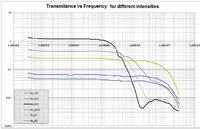- Joined
- Oct 9, 2009
- Messages
- 10,865
- Helped
- 2,065
- Reputation
- 4,130
- Reaction score
- 1,596
- Trophy points
- 1,403
- Location
- Yorkshire, UK
- Activity points
- 57,270
They are all a lot faster than I would be looking for in your case. The TSH350 and EL5191 are current feedback, so not a good choice. EL1516 may be OK but there is no Spice model. It claims to be an improved EL2227 and I have a model for that and it looks OK, but the EL1516 has a lot higher bandwidth. 2.2k feedback would require around 2.2pF across it and give 50MHz bandwidth. The LT1806 seems a little peaky at first look - I would need to look in more detail to find out why. If you could find something with a lower bandwidth (e.g. EL2227) then I would think you are less likely to have problems.
Keith.
Keith.


